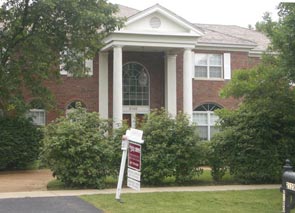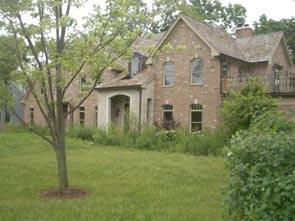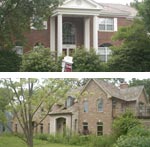
Glenview home on the conventional real-estate market |

A Foreclosed house across the street. |
The latest reports show that the tide of foreclosures keeps rising. Last week, Realty Trac reported that one of every 538 mortgaged homes in Illinois is in some stage of foreclosure. (In the Chicago metropolitan area, Kane County had the highest concentration—1 in 415 mortgages—and DuPage County had the lowest: 1 in 734.) The week before, the Mortgage Bankers Association reported that 2.5 percent of all mortgages were in foreclosure during the first quarter of 2008—nearly twice what they had been a year ago.
For homeowners who haven’t seen the board-ups and tall weeds that mark many foreclosed properties, the problem may seem remote, something that mainly afflicts people in low-income areas. Though it’s true that foreclosed properties are generally concentrated in lower-cost places, the wave of foreclosures is also sweeping into higher-priced areas. And while the effect of a few foreclosed properties on upscale neighborhoods may be nothing like the decay that many experts have predicted for the low-income centers of foreclosure, there will be some spillover.
Consider Glenview’s Sunset Ridge Road, a pretty suburban street lined with old horse properties, ranch houses, and larger homes built over the past several years. On one block, a relatively new house (pictured on the right)—valued at $1.85 million two years ago and likely never occupied—is now being sold by a bank at a sharp discount. Directly across the street sits a nice older house (pictured on the left) that went on the conventional real-estate market earlier this month with a price tag of $1,399,000.
The foreclosed house had its origins in 2005, when, according to the Cook County Recorder of Deeds, a builder paid $450,000 for the small house already occupying the quarter-acre lot there. The builder tore down the small house and put up the new residence, which he sold in October 2006 for $1.85 million. According to the county recorder, the buyer—who may have never moved in—was already delinquent on her payments seven months later, and in January 2008, the bank took over the property. The five-bedroom brick house is now listed with Rising Realty for $1,449,000. (As reported here last March, Rising Realty specializes in selling foreclosed houses and condos for the banks that take possession of them.)
Today, weeds rise above the first-floor windowsills of the foreclosed house, which is obviously empty. Somebody has been mowing the lawn, but the property is still “an eyesore to look at,” says the woman who lives across the street in the 14-room brick colonial currently listed for sale at $1,399,000. (She asked not to be identified.) Built in 1991, her house stands on a half-acre lot and has six bedrooms, marble baths, a butler’s pantry, and two laundry rooms. Clearly the woman’s house has a lot going for it, but as she points out, potential buyers “look out from the curb and see that place”—the one, she says, with weeds so thick “you probably have to walk through some to get to the front door.”
Rising Realty’s Menash Zadik notes that the foreclosed house—priced higher than the older house despite its smaller lot—may have more appeal for some buyers. “People do like to buy new,” says Zadik. “Things have changed since [the older house] was built in 1991; closets are bigger, kitchens are more open. This one [the new house] doesn’t even seem to have had anybody in it. There are none of the scratch marks on the floor from moving in.”
In some cases, having a foreclosed house nearby might give potential buyers the wrong idea about a house with a conventional listing. “Neighborhoods that have foreclosures in them give the perception that people can come bargain,” says David Hanna, the managing partner at Prudential SourceOne Realty and the president-elect of the Chicago Association of Realtors. On Glenview’s Sunset Ridge Road, Hanna says, people might even bid aggressively low on the older house, almost as if it too were a foreclosure.
The Center for Responsible Lending estimated recently that the value of property near a foreclosed home will drop an average of $5,000. Much of that drop comes from a lowered perception of the neighborhood’s quality.
A foreclosed house may even dampen its own potential to get sold: as Hanna points out, some buyers see a stigma in buying a foreclosed home, no matter where it’s located—even if it is new. “You’ve got no recourse with the builder,” he says. “You don’t know what’s behind those walls.” Contractors might have cut corners to finish the job fast if they knew the builder’s finances were unsteady.
Hanna is speaking generally, so it’s hard to say what will happen on Sunset Ridge Road. In the end, the sale of the older but lower-priced Glenview house might not be affected at all by its weedy, empty neighbor. At the moment, there’s no way to tell. “It’s a slow market,” says the woman selling the older house. “We haven’t had many showings yet.” But you can bet that anybody looking to spend over $1.3 million to buy here is going to wonder what’s up across the street.
 The latest reports show that the tide of foreclosures keeps rising. Last week, Realty Trac reported that one of every 538 mortgaged homes in Illinois is in some stage of foreclosure. (In the Chicago metropolitan area, Kane County had the highest concentration—1 in 415 mortgages—and DuPage County had the lowest: 1 in 734.) The week before, the Mortgage Bankers Association reported that 2.5 percent of all mortgages were..." />
The latest reports show that the tide of foreclosures keeps rising. Last week, Realty Trac reported that one of every 538 mortgaged homes in Illinois is in some stage of foreclosure. (In the Chicago metropolitan area, Kane County had the highest concentration—1 in 415 mortgages—and DuPage County had the lowest: 1 in 734.) The week before, the Mortgage Bankers Association reported that 2.5 percent of all mortgages were..." />



